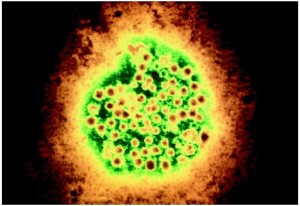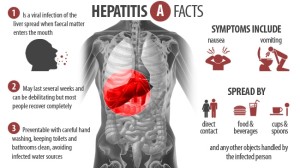That was barroom discussion in graduate school 30 years ago, but not all hosts die because then there’d be no where for the viruses to have babies..
Scientists have announced that for the first time, they have determined the precise atomic structure of the Hepatitis A virus. In an unprecedented step forward, a team of scientists from Beijing and Oxford have been able to map the exact construction of Hepatitis A, down to the individual atoms. This new finding is a considerable advance for research into Hep A, one of the most resilient and difficult to control viruses and more broadly for our understanding of the virus world. The findings are published today, in the publication Nature.
Despite an existing vaccine, Hep A continues to infect 1.4 million people every year. It causes infection of the liver and symptoms can include diarrhoea, vomiting, yellow skin, fever, and abdominal pain. These findings are particularly significant due to the unique qualities of the virus. Hep A is particularly hardy unlike other viruses in the picornavirus family, which includes polio and the common cold. Hep A is able to withstand remarkably high temperatures and remain stable in hostile environments, making it difficult to control infection. It also has a unique, enveloped form, allowing it to shroud itself in the host membrane, making it harder for the body’s immune system to detect.
This discovery is ground-breaking in terms of what it reveals about the history and evolution of viruses. The findings suggest that Hep A may be the evolutionary ‘missing link’ between picornaviruses, which infect humans and animals, and some insect viruses.
By scrutinising the atomic structure of the virus, the team from the University of Oxford identified that Hep A possesses characteristics of both ancient insect viruses and modern human viruses such as polio. The methods by which it infects host cells, the very limited range of cells in which it thrives and the sheer stability of Hepatitis A all point towards it having somehow become stuck along the evolutionary trail. Where other viruses in the same picornavirus family developed into the structures we know today, Hepatitis A has remained forever frozen between the old and the new.
Hep A has proved difficult to study in the past. Using the advanced X-ray techniques at the UK’s synchrotron science facility, Diamond Light Source, scientists were able to study the vir us at an atomic level. Diamond Light Source, is the UK’s national synchrotron, a giant x-ray machine the size of Wembley Stadium. It is the largest science machine the UK has ever built and produces a light 10 billion times brighter than the sun. 3,500 scientists and industry users from the UK and across the world, visit the synchrotron every year, to carry out cutting-edge scientific research.
us at an atomic level. Diamond Light Source, is the UK’s national synchrotron, a giant x-ray machine the size of Wembley Stadium. It is the largest science machine the UK has ever built and produces a light 10 billion times brighter than the sun. 3,500 scientists and industry users from the UK and across the world, visit the synchrotron every year, to carry out cutting-edge scientific research.
Viruses are some of the oldest and most pervasive elements of the natural world. There are more viruses on Earth than all bacteria, plant and animal life combined, and they can evolve much faster than any living thing. Because they are so diverse and develop so quickly, it can be difficult to work out how they are related and how they evolved. Scientists know enough to group similar viruses into different families, but the question of their history and how these families came to exist in their current form has been very difficult to unravel.
Recent advances in technology have allowed scientists to look more closely at the structures of challenging viruses. Upgrades to facilities for analysing viruses at the Diamond synchrotron – which produces powerful X-ray light for scientists to use in their research – make it easier for whole viruses to be scrutinised in minute detail. Using Diamond’s crystallography ‘beamlines’ the group has uncovered vital new insights into how viruses have evolved.
Dave Stuart, Professor of Structural Biology at Oxford University and Head of Life Sciences for Diamond Light Source led the research into Hepatitis A. He points out exactly why these findings are so significant: “Viruses are too small and fragile to leave a fossil record, and change so quickly that many people would despair of piecing together the story of their evolution, so it is wonderful to see that their intricate details show mechanisms that form missing links between different families.”
The message is clear: the more we know about virus history and relationships, the more prepared we are to tackle viruses that pose a serious threat now and in the future; that’s why it’s so important to understand the fundamental atomic processes required for a virus to replicate and survive. This underpinning knowledge is the groundwork for the next stage, the production of improved vaccines and effective anti-viral drugs. Using advanced new technology such as Diamond, scientists are able to unpick the mysteries of even the most enigmatic viruses, atom by atom.
The findings are published today in the publication Nature. The paper is entitled ‘Hepatitis A virus and the origins of picornaviruses’.

